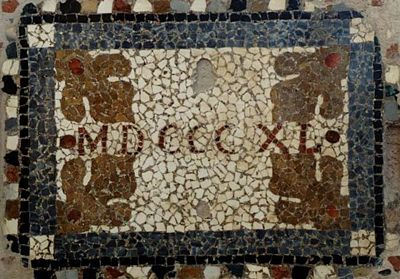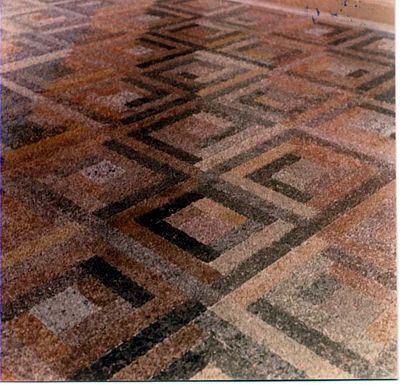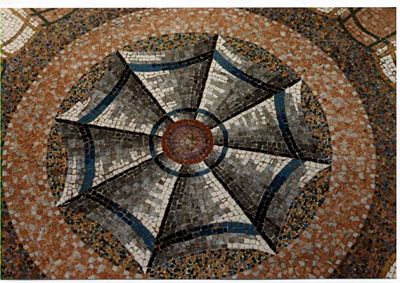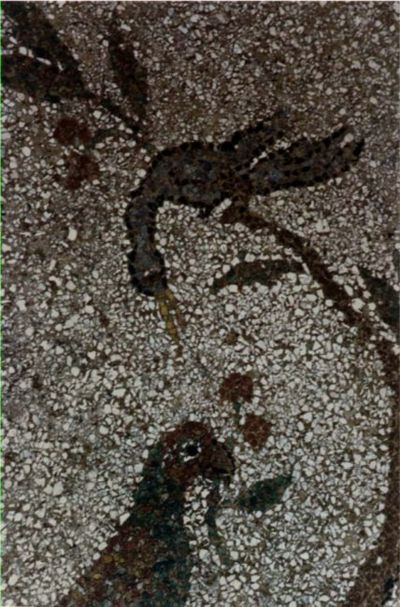Floor in venetian Terrazzo
Da Venicewiki, il wiki di Venezia
There's Palace, church, home or shop in Venice who has not, or has not had the Floor Venetian commonly called Terrazzo.
The advantage of this construction is all in his ability to adapt to all the surfaces and to each situation. The main distinction is between Terrazzo in lime, or Terrazzo in cement, the less valuable.
The difference is substantial: the first is flexible and adapts to the movements of the building in which it is located, the second, recently created, in fact, the cement was invented in the late 1800s, is stiff and cold to the touch.
Indice |
Construction techniques
There are two techniques to build terraces to the Venetian, and are related to the binder used: slaked lime (also known as the only lime) and cement. It 'obvious that the technique of the floor built with lime is the most ancient, in consideration of the fact that the cement, as we know it today, is born in the last decades of the nineteenth century, lime requires the most experience and is more expensive.The types of terrazzo floors that can be constructed are varied and depend on the size of the granules used, colored marbles chosen, but also by the effect of composition that comes from the mixture of two or more varieties of slivers of marble and colors used. It should be added that, even if the layers of the material in their writing have the same sequence, the construction technique changes completely in relation to the binder used. </poem>
Flooring lime
Verification and protection of the wooden board
To describe the technique of construction of the floors below, we start from the layer beneath the floor: the beams and planks. These should be checked and tested before beginning the process of installation.
Special care must be used in the joints between the masonry and the plank; In fact, it often happens that the withdrawal of the wood or a clumsy combination of tables, portions of material thrown to its structure in the interstices making collapsing part of the same. At that point, in the floor, urged by the steps of the people, it will be to form a depression tion or even a hole, that only an intervention will strengthen the plank, but intervention will prove difficult and destructive of what will be required.
Once verified the compactness of the plateau and its homogeneity, it is necessary to protect it, lie above a protective layer, because the lime corrodes the wood. As we are shown by the engravings of Rusconi, anciently, to overcome this problem, we resorted to the use of the ferns. Currently are laid sheets of roofing felt which are well suited to this need.
Formerly it was kneaded in a special place, with a hoe, to dissolve well as lime and being able to mix well with the inert. Today is executed all with a cement mixer, in which is dissolved with water and then the lime is added to the correct proportion of inert.
This will be kneaded, with a ratio of five to one, with lime. E 'preferable that all the material that must be used for the casting of the substrate is kneaded even a few days before the casting itself, to have a homogeneous mixture. It will then proceed to the drafting of the substrate.
The thickness of the substrate can range from a minimum of ten centimeters thick to get to the limit, as they were found in Palazzo Cavalli San Marco, thicknesses in the third floor of 60 70 cm. In making patchworks, also of great size, it was not enough to run a single substrate, but it took them two, this because otherwise the jet could not have been done as well compact needs, so relatively quickly would crumbled creating voids below, and sagging.
The laying of the foundation is performed with staffs proportional to the magnitude of the places to floor. The old terazeri claimed that years ago, when they were boys, there was no variety of staffs and often large areas were laid with relatively small staffs. For this reason it happened that the floors were not perfectly flat, "bubble". Add to this the bending of the beams, some structural failure and consequently also to maintain the furniture perpendicular require the addition of wedges.
We must not destroy, as is often the case today, the floors only. I am a finding that we must care for and maintain, because nowadays no one is able to perform the same.
Compacting the substrate is then further processing, which is performed with rollers (or columns) and pile drivers for the central part and a specially shaped iron, the blade, for perimeter zones.
It's curious to hear the able teraziere beat with the pile driver. The sounds, rhythm, indispensable to feel less fatigue, resembles a time to dance. Three shots of bedding and a quarter to lower the part not yet touched. A time of four quarters with emphasis on the fourth beat.
In areas where the pile driver will do the column can compact the substrate, then the parts attached to the walls, the operation is performed with the hammer and knife, with some well placed shots.
When the floor begins to dry and the pile driver leaves no trace on the surface after the joke, (also the stamp of the latter course is changed) is the time to let stand the background because it is completely dry. Takes an average of six months for this to happen before you can start with the next task: the pegging of the substrate.
The pegging is the process by which, with a pointed tool such as a pickaxe or edge of a shovel, creating small holes on the smooth surface, spaced about thirty cm from each other. These holes serve as an anchor to the next layer, lest the effect "folder", in other words the gap, then the movement of the surface layer.
It often happened that, not to remake the background, you picchettasse directly on the floor that was to cover as worn by overlapping so the new floor to the old one for which you came, in time, to darkened or four overlapping of different floors.
Cleaned the surface from the resulting material of pegging, you need to wet it thoroughly because the substrate to absorb a lot of water and do not dry out too quickly the layer that is used over: the blanket.
The pastellone

The substrate as above performed well staked, is spread "another coat or blanket," as Sansovino, terracotta pesto and lime to which could be added Istrian marble chips (proceedings to which I think are received only by accident).
Firmed the blanket almost to full cure, is spread over and pressed with appropriate tools, lime and marble dust with appropriately colored "cinapro, or red", less often yellow and rarely green. Terazeri Experts were able to run floors of a color with the side bands of different color.
Constipation subsequent hands is done with tools increasingly small to exert increasing pressure on the layer above. The pastellone so composed and so constipated eliminates the portion of water that is still present. Since the lime a breathable material, the water is eliminated by evaporation, however, if the environment is sufficiently cold, this collects in drops such as to look like a body that transpires.
After drying is given the raw linseed oil until absorbed by the total floor. The polishing is done by wiping with rags jute until a shiny surface "that a man can be reflected" (tale che un uomo possa specchiarsi).
Cement Floors
The construction technique of concrete floors does not differ much from that of the floors at the bottom. The substantial difference is in the binder. The cement, owing to its technical characteristics, hardens very quickly, so Processing must also undergo this acceleration. A floor that you get to throw, must be completed in the same day.
Prepared and spread the first layer of blanket duly mixed with water, with a leveling rod is laid dry the layer of stabilidura to dry. Only when this has absorbed a bit 'of water from the deck and it is wet, you start sowing itself. The attention that was necessary for the sowing of the floor at the bottom, comes to be much lower than in that of cement. If the marble chips are overlapped, when they are made to incorporate in stabilidura, are shrouded in the same binder that holds.
At the marble powder is added, almost always, the dye for the cement to give a coloration to the bottom which would otherwise be only gray. They are used for this design oxides of different nature and of different color according to the color desired. There oxide green, blue, white, but the most used are red, yellow and black.
Instead you have to have special regard for the white cement. Of a different nature than normal gray, has setting times significantly different, and therefore also different processing times. Drying more quickly, does not leave the time required for processing and "break the hold" to the white cement, ie work even after the socket has started, means losing the consistency of the binder and the floor so executed crumbles. To overcome this drawback, it is necessary to add a white cement empowering the socket, but also with this arrangement the floor may, in relatively short times, to create micro-cracks that will be highlighted by the polishing of the floor itself.
Wet abundantly, the marble chips are embedded in stabilidura and covered with roller and iron bater. With a brush is then checked that each part is fully incorporated. So it is left to dry. The very next day is walkable, but not yet well established. We must consider the characteristics of taking cements: setting time, setting time, curing time. The setting time is the period of workability of the cement can be a maximum of eight hours. The hardening time is the period in which the cement comes to the critical resistance, about three days. The curing time leading the resistance to the standard conditions, the fateful 28 days. But we must consider also a time, sufficiently large, which leads to complete the curing cycle, the cycle variable, depending on the climatic conditions, from six months to a year.
If the polishing happen after the curing time of the cement will have a shinier floor and marble chips will be at the same level of the binder.
Even on concrete floors can make drawings or decorations, but the process is quite different from the floor at the bottom. On deck are implanted the wooden shapes that depict the design to perform. Everything is done around the floor and the next day, with great caution, the shapes are removed and the space filled with different colored marble. So you can make simple decorations such as bands or ornaments, or real mosaics such as those performed for Versace in his shop in Venice, which were performed in the dolphins jump and a head with snakes instead of hair depicting Medusa.
The concrete floor has the following significant advantages over lime. It can perform the jets that, once hardened, may also be placed vertically, as of the marble slabs, for wall covering or for covering or the creation of real shelves for bathrooms or kitchens. Already the vastness of the varieties of marble leaves plenty of choice, but if we add to marble the different grain size, the different coloring or adding small areas sown mosaic, here is that the variety of this type of surface becomes endless.
Special processes such as granite kneaded were performed in the early years of this century to save materials. This was used for the construction of steps, jambs of windows, of columns that hold very little weight, balustrades, as well as floors that were still smoothed by hand and also to the classic kitchen sink which we all remember d ' childhood.
Granite floors kneaded were performed also at the bottom, but usually only in the areas of service or in the servants' quarters.





